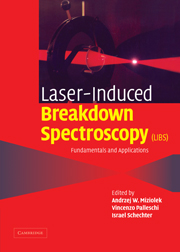Book contents
- Frontmatter
- Contents
- List of contributors
- Preface
- 1 History and fundamentals of LIBS
- 2 Plasma morphology
- 3 From sample to signal in laser-induced breakdown spectroscopy: a complex route to quantitative analysis
- 4 Laser-induced breakdown in gases: experiments and simulation
- 5 Analysis of aerosols by LIBS
- 6 Chemical imaging of surfaces using LIBS
- 7 Biomedical applications of LIBS
- 8 LIBS for the analysis of pharmaceutical materials
- 9 Cultural heritage applications of LIBS
- 10 Civilian and military environmental contamination studies using LIBS
- 11 Industrial applications of LIBS
- 12 Resonance-enhanced LIBS
- 13 Short-pulse LIBS: fundamentals and applications
- 14 High-speed, high-resolution LIBS using diode-pumped solid-state lasers
- 15 Laser-induced breakdown spectroscopy using sequential laser pulses
- 16 Micro LIBS technique
- 17 New spectral detectors for LIBS
- 18 Spark-induced breakdown spectroscopy: a description of an electrically generated LIBS-like process for elemental analysis of airborne particulates and solid samples
- Index
- References
16 - Micro LIBS technique
Published online by Cambridge University Press: 08 August 2009
- Frontmatter
- Contents
- List of contributors
- Preface
- 1 History and fundamentals of LIBS
- 2 Plasma morphology
- 3 From sample to signal in laser-induced breakdown spectroscopy: a complex route to quantitative analysis
- 4 Laser-induced breakdown in gases: experiments and simulation
- 5 Analysis of aerosols by LIBS
- 6 Chemical imaging of surfaces using LIBS
- 7 Biomedical applications of LIBS
- 8 LIBS for the analysis of pharmaceutical materials
- 9 Cultural heritage applications of LIBS
- 10 Civilian and military environmental contamination studies using LIBS
- 11 Industrial applications of LIBS
- 12 Resonance-enhanced LIBS
- 13 Short-pulse LIBS: fundamentals and applications
- 14 High-speed, high-resolution LIBS using diode-pumped solid-state lasers
- 15 Laser-induced breakdown spectroscopy using sequential laser pulses
- 16 Micro LIBS technique
- 17 New spectral detectors for LIBS
- 18 Spark-induced breakdown spectroscopy: a description of an electrically generated LIBS-like process for elemental analysis of airborne particulates and solid samples
- Index
- References
Summary
Introduction
The LIBS technique (laser-induced breakdown spectroscopy) has been applied mainly for the bulk analysis of solids [1], liquids [2], or gases [3], but more sparsely for elemental microanalysis of solid surfaces. In this chapter we describe different results obtained with a micro LIBS device devoted to element distribution analysis on solid surfaces and to localized analysis. The crater diameter and its shape are two crucial parameters that have to be well controlled to obtain reliable results. After a description of different published results concerning micro plasmas and recent applications of surface analysis, a complete description of a laboratory micro LIBS device is reported. The smallest crater diameter achieved with the experimental set-up and that can be used for analytical purposes is 3 μm. An original device offering an attractive feature to obtain regular spaced craters is also presented. The characteristics of the system in terms of quantitative analysis are highlighted. Different element distributions on surfaces of ceramics and steel samples are shown to demonstrate the very high potential of micro LIBS for elemental microanalysis. Finally, the micro LIBS technique is presented as a powerful analytical method for geological samples.
The use of a microscope combined with a laser has been reviewed previously [4]. This present chapter provides information on technical details of manufactured microanalyzers combined with a spark-gap device, positioned above the sample surface, to make localized analysis. With the different manufactured systems, crater diameters from laser ablation could vary from 10 μm to 1 mm.
Information
- Type
- Chapter
- Information
- Laser Induced Breakdown Spectroscopy , pp. 539 - 555Publisher: Cambridge University PressPrint publication year: 2006
References
Accessibility standard: Unknown
Why this information is here
This section outlines the accessibility features of this content - including support for screen readers, full keyboard navigation and high-contrast display options. This may not be relevant for you.Accessibility Information
- 1
- Cited by
